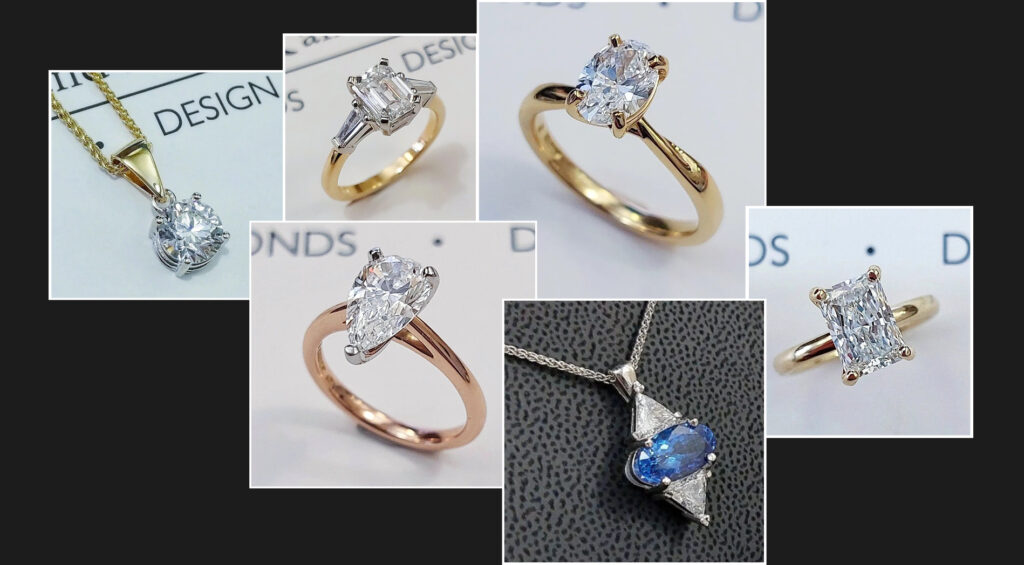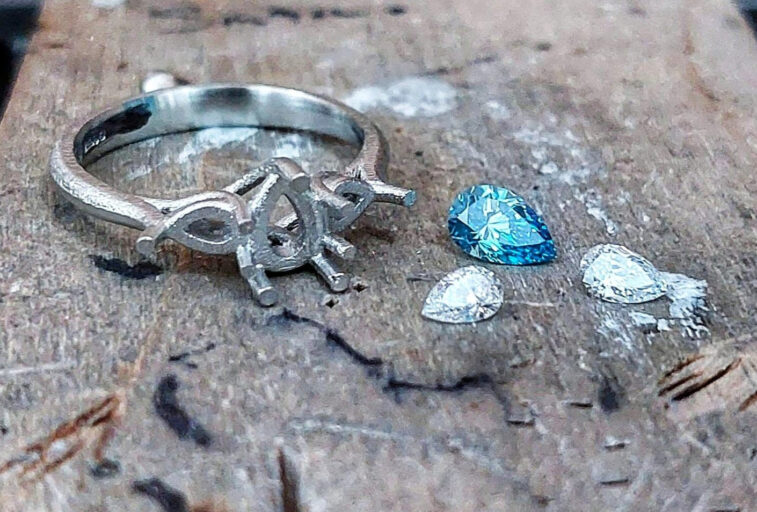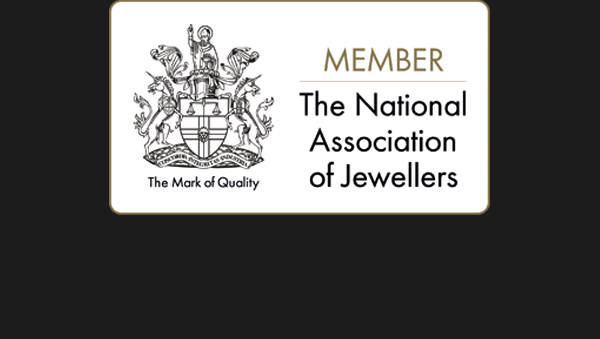KELVINBRIDGE · GLASGOW
|TEL 0141 334 0557
BOOK NOW FOR IN-HOUSE ONE TO ONE OR VIRTUAL/REMOTE CONSULTATIONS
Diamonds are forever – picking the right cut and style for your bespoke jewellery design
- Date: 8th May 2024
- Author: Blair & Sheridan
Diamonds come in an endless variation of shapes and sizes. Most people will have heard of the ‘4 Cs’ (colour, cut, clarity and carat size); however, there is far more to consider when you are contemplating your next bespoke diamond ring or jewellery design. The go-to for engagement rings, the ultimate luxury in jewellery design and so called ‘girls best friend’… let’s get a bit more familiar with the revered and illustrious Diamond…
Formed approximately 100 miles beneath the earth’s crust, diamonds are carried to the surface by volcanic activity. Without these eruptions, diamonds would have remained deep within the earth never to be found. Man’s earliest discovery of natural diamonds goes back around 4000 years in remote Indian caves. Due to the extreme durability of these precious stones it was several hundred years before primitive cutting, polishing and shaping began. The first diamond mines were discovered in India and date back to around 800BC – until the 17th century, India was thought to be the only known source of diamonds and remained the dominant producer until the 18th century. It was well into the 20th century that diamond-cutting techniques were advanced enough to create the shape and quality of diamonds as we know today.
Revered by ancient Indian rulers as divine objects, early diamond discoveries remained in their rough outer shell and were thought to ward off evil spirits and protect the owner in battle. By the middle ages the popularity of diamonds had reached Europe and they were representative of opulence, wealth and power. The development of diamond cutting saw these rare stones transformed into stunning sparkly pieces – often adorned by royalty – which were soon coveted by the wealthy.
Only around 30% of mined diamonds are gem quality and suitable for use in commercial jewellery. Lesser quality diamonds are utilized by the following industries:
Audio (eg speakers and stylus), Automotive (eg tools used in car production), Pharmaceutical (nanodiamonds can indicate the effectiveness of cancer treatment), Beauty Products (diamond-infused products are said to reduce wrinkles) and Construction (saws, drill and other tools).

Five diamond facts:
- Diamonds are the only gemstone made from one element: carbon
- The word ‘diamond’ is derived from the Greek word ‘adamas’ which translates as invincible or indestructible
- Diamonds are the earth’s hardest natural substance and can only be scratched by another diamond
- A 30 Carat diamond can withstand the pressure of the weight of the Empire State Building
- The first known diamond engagement ring was gifted from the Archduke Maximilian of Austria to his betrothed; Mary of Burgundy.
Lab grown diamonds have grown in popularity in recent years with them being made more widely available to the jewellery market. Offering a more sustainable alternative to someone looking to purchase diamonds, Lab grown stones come in the same variety of size, shape, colour etc as mined diamonds. Read more about Lab Grown diamonds here.
Diamond terms
- Inclusions: also referred to as flaws
- Table: this is the flat surface to the top of the stone and is the largest facet of the diamond
- Facets: these are the flat polished surfaces of the diamond – the number of facets depends on the cut of the stone, a standard round brilliant diamond has 58 facets.
- Brilliance: this is the term used to measure the proportion of light reflecting back to your eye through the top of the stone. Brilliance is what makes your diamond sparkle.
- Fire: also known as dispersion, light enters the top of the diamond and is refracted into a rainbow of colours which results in flashes of colour to the naked eye.
- Crown: this is simply the top part of the diamond when looking at it side on – the depth of the crown affects the amount of fire and brightness it produces.
- Scintillation: when you move a diamond about you will notice a display of light and sparkle on its surface, this is known as it’s scintillation.
When you are looking for a bespoke diamond ring or jewellery design, here at Blair and Sheridan we will guide you through the entire journey. We will explain the characteristics of various diamond cuts and shapes helping you come to an informed choice – we source diamonds specific to your specification and you can view a selection of unique stones at the early stages of the design process.
Popular diamond cuts explained:
- Asscher Cut – flat table, large step facets and a high crown. Square in shape with truncated corners giving it the impression of an octagon shape. These stones have an antique/vintage feel to them
* Pippa Middleton’s engagement ring holds an impressive Asscher cut diamond of approx. 3 carats. - Cushion – characterized by its soft square or rectangular shape (this variation is known as an ‘elongated cushion’) resembles a pillow shape. Known for their antique feel, cushion cut diamonds hold excellent brilliance and fire.
* Priyanka Chopra, Zoe Kravitz, Kate Bosworth and Meghan Markle all wear Cushion cut diamond engagement rings. - Emerald Cut – clean, crisp parallel lines with 57 facets and cut off corners – emerald cut diamonds offer the wearer the look of elongated fingers when worn on a ring.
* Liz Taylor, Grace Kelly, Beyonce, Jennifer Lawrence, Amal Clooney, Gwen Stefani and Melania Trump can all be seen flashing impressive emerald cut diamonds on their wedding finger.
- Heart Cut – the unmistakable symbol of true love, heart-shaped diamonds are one of the lesser known diamond shapes. Heart shaped diamonds are one of the most difficult to cut due to their requirement for exact symmetry.
* Rochelle Humes, Lady Gaga and Avril Lavigne have been proposed to with quirky Heart cut diamond ring.M - Marquise Cut – elliptical in shape with pointed corners and brilliant facet structure – a very versatile cut that is equally suitable as a solitaire or as side stones on a trilogy. The length to width ratio is an important factor with 2:1 being considered the optimum.
* Ellen DeGeneres, David Beckham and Michael Douglas all got down on one knee with Marquise cut diamond engagement rings. - Oval Cut – aptly named for their elongated oval shape and cut in the brilliant style, Oval Cut diamonds can help elongate your fingers and they are often paired with side stones to form a trilogy design ring.
* As seen on Blake Lively, Kourtney Kardashian, Simone Biles, Hailey Bieber and Serena Williams.
- Pear Cut – with one pointed end and one rounded, the Pear Cut diamond blends the look of a Marquise and an Oval cut. Unique for its asymmetry and, like a marquise and oval, the pear cut has its two largest facets in the centre – considering how the stone has been cut is crucial to display these two facets
* Liz Taylor famously wore a 69.42 carat pear cut diamond on a pendant at the 1970s Oscars – the diamond was gifted to her by Richard Burton and goes by the name of ‘the Taylor-Burton Diamond’. - Princess Cut – traditionally square cut, the side view of a Princess Cut appears as an inverted pyramid and offers a geometric shape with strong lines. Modern cut, this shape was the most popular for some time but has been surpassed by round cut.
* Hilary Duff’s first marriage to Mike Comrie featured a $1 million 14 carat Princess cut diamond engagement ring. - Radiant Cut – with an outline the same as an emerald cut, Radiant cut diamonds facet structure resembles that of a round brilliant cut diamond and they are known for their ‘crushed ice’ or ‘brilliant’ sparkle.
* Gwen Stefani’s jaw-dropping Radiant cut diamond engagement ring reportedly cost $500,000.
- Round Brilliant Cut – easily recognized with 360 degree symmetry, the 58 facets of a round brilliant cut produce a sparkle like no other diamond shape.
* Kate Bosworth and Mila Kunis both have solitaire diamond engagement rings sporting a round brilliant cut. - Trilliant Cut – resembling a triangle shape, trilliant cut diamonds can be used as a solitaire or as accent/side stones. This cut has three equal sides which can be either straight or slightly curved.
* most commonly used as side stones, Trilliant cut diamonds paired with a stunning blue sapphire on the engagement ring gifted to Liz Hurley by Shane Warne.
If you are ready to pick your next diamond or would like to find out more about having a piece of bespoke jewellery or ring designed exclusive to you, then get in touch with Blair and Sheridan today. Our unrivalled service and wonderful customer reviews speak for themselves.
CATEGORIES
Archives
- June 2025
- April 2025
- March 2025
- December 2024
- November 2024
- August 2024
- June 2024
- May 2024
- March 2024
- February 2024
- January 2024
- December 2023
- November 2023
- August 2023
- June 2023
- April 2023
- February 2023
- December 2022
- August 2022
- July 2022
- May 2022
- April 2022
- January 2022
- November 2021
- September 2021
- June 2021
- April 2021
- November 2020
- August 2020
- April 2020
- March 2020
- February 2020
- January 2020
- May 2019
- March 2019
- October 2018
- May 2017
- April 2017
- March 2017
- February 2017
- January 2017
- March 2016
- October 2015
- June 2015
- May 2015
- April 2015
- March 2015
- February 2015
Recent Posts
- Adding colour to our craft: introducing coloured diamonds and gemstones to your bespoke jewellery
- Bespoke diamond engagement rings don’t have to cost the earth…
- Planning your wedding – it’s all in the detail
- The best things come in threes…. a guide to bespoke trilogy rings
- Crystal clear, keeping the sparkle in your bespoke jewellery
CONTACT US
- Blair and Sheridan
- Bespoke Diamond Jewellers Glasgow
- 417 Great Western Road
- Kelvinbridge
- Glasgow G4 9JA
- T: 0141 334 0557
- E: info@blairandsheridan.co.uk
RECENT NEWS
COPYRIGHT © 2018 BLAIR AND SHERIDAN | BESPOKE DIAMOND JEWELLERS GLASGOW, SCOTLAND SC 412681 VAT No. GB 131 6499 13 | Terms & Conditions | Privacy Policy | Contact Us



